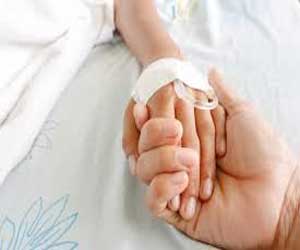- Home
- Editorial
- News
- Practice Guidelines
- Anesthesiology Guidelines
- Cancer Guidelines
- Cardiac Sciences Guidelines
- Critical Care Guidelines
- Dentistry Guidelines
- Dermatology Guidelines
- Diabetes and Endo Guidelines
- Diagnostics Guidelines
- ENT Guidelines
- Featured Practice Guidelines
- Gastroenterology Guidelines
- Geriatrics Guidelines
- Medicine Guidelines
- Nephrology Guidelines
- Neurosciences Guidelines
- Obs and Gynae Guidelines
- Ophthalmology Guidelines
- Orthopaedics Guidelines
- Paediatrics Guidelines
- Psychiatry Guidelines
- Pulmonology Guidelines
- Radiology Guidelines
- Surgery Guidelines
- Urology Guidelines
Safety of pediatric patient should be a priority, declares AAP

Highlighting common errors, the American Academy of Paediatrics has declared that Safety of a pediatric patient should be a priority. The policy, from the Council on Quality Improvement and Patient Safety, will be published in the February issue of Pediatrics.
A child is seen in the paediatrician's office after a lengthy hospitalization for a complex problem. The physician has not yet received the discharge summary or talked to the hospital team. The mother mentions that several new medications were started during the hospitalization but doesn’t recall the names. During the exam, the paediatrician notices some changes compared to a previous exam. He has about 20 minutes to determine whether the changes could be due to the underlying disease, the interventions performed in the hospital or a medication side effect and to provide ongoing care and counselling to the family.
This is a common scenario that can result in errors, many of them rooted in lack of communication among care providers. The updated AAP policy statement Principles of Pediatric Patient Safety: Reducing Harm Due to Medical Care sets expectations that can prevent such problems and summarizes practices to minimize pediatric medical errors and improve the quality of care.
Children are at risk for the types of errors that occur in adults (e.g., diagnostic errors, identification errors due to wrong spelling of names or wrong birthdates, over-treatment or under-treatment, misfiled or overlooked test results). They also are at particular risk for medication errors due to age-related changes in drug metabolism, height and weight, and their dependency on parents and other care providers.
Several studies have documented the frequency of errors in the inpatient setting, but less is known about the ambulatory environment or the transition from one to the other, like in the vignette.
The preventive strategies with the most potential to reduce errors are improved communication between providers and parents, between pharmacists and parents, and between providers (hand-offs). In community and adult settings, there is an added need to advocate for pediatric-specific issues. Physician participation on key hospital committees, such as the pharmacy and therapeutics committee and the information technology committee, as well as community committees addressing ambulatory clinical practice, is invaluable.
Speaking up
In addition to being aware of all the potential causes for error, it is important to develop a culture of safety, where everyone, including patients and parents, are encouraged to speak up about their safety concerns. A culture of safety focuses on fixing systems that let caregivers make mistakes, since a health care provider rarely acts maliciously or recklessly. Most of the time, well-meaning people lack knowledge, are in a hurry and take short-cuts, or the system makes it too easy to commit an error.
Following are recommendations for health care providers and organizations caring for children:
- Raise awareness and improve working knowledge of pediatric patient safety issues and best practices throughout the pediatric community through education and training.
- Use networks to encourage the sharing of patient safety issues and best practices among clinicians (see resources).
- Create a safety culture, making it easy for anyone to speak up.
- Implement standardized protocols of care for specific conditions, such as checklists or clinical practice guidelines, and monitor adherence.
- Improve health care outcomes for children by adhering to proven best practices for improving pediatric patient safety.
Here is what should have happened in the opening scenario:
The physician has already talked with the hospital physician and received the discharge summary with the list of all medications and test results (including pending ones), as well as information on plans for future treatments. The pediatrician performs a physical exam and notices some changes compared to a previous exam, but he can assure the family that these are expected changes. He encourages the family to contact him with any new concerns or questions.

Disclaimer: This site is primarily intended for healthcare professionals. Any content/information on this website does not replace the advice of medical and/or health professionals and should not be construed as medical/diagnostic advice/endorsement or prescription. Use of this site is subject to our terms of use, privacy policy, advertisement policy. © 2020 Minerva Medical Treatment Pvt Ltd